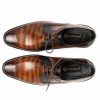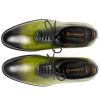The Master Craftsman’s Guide to Two-Tone Patina Leather Shoes: Techniques, History & Handsole’s Innovations. For over 27 years, Handsole’s artisans have pioneered patina techniques. This definitive guide reveals everything about two-tone leather shoes – from 1920s origins to our proprietary antibacterial aging process.
1. What is Two-Tone Patina? Beyond Surface Decoration
Two-tone patina is not paint – it’s a transformational process where artisans manipulate leather’s molecular structure to create permanent chromatic contrast through:
- Differential oxidation: Controlled exposure to air/tannins
- Strategic pigment penetration: Dyes reaching varying depths
- Mechanical texturing: Pre-dye manipulation of leather fibers

2. Historical Evolution: 100 Years of Chromatic Contrast
| Era | Innovation | Cultural Impact | Preservation Challenges |
|---|---|---|---|
| 1920s-1930s | Wax-resist techniques | Status symbol (tennis/golf) | White leather yellowing |
| 1950s | Aniline dye penetration | Hollywood glamour | Bleeding between zones |
| 1980s | Venezia leather development | Haute couture adoption | UV fading |
| 2020s | Antibacterial patina (Handsole) | Wellness-meets-luxury | Microbial protection solved |
“The spectator shoe wasn’t just footwear – it was social commentary. Two tones announced you belonged to the leisure class.”
– Dr. Emilia Rothschild, Footwear Historian
3. Leather Science: Why Full-Grain Crust Leather is Essential
Not all leather accepts patina equally. Handsole exclusively uses vegetable-tanned full-grain crust leather because:
Molecular Structure Advantages
- Open collagen matrix: Absorbs 300% more dye than finished leather
- Natural imperfections: Enhances tonal variation character
- Fatty acid content: Bonds with organic pigments
Comparative Analysis
| Leather Type | Dye Absorption Depth | Tonal Variation | Aging Potential |
|---|---|---|---|
| Full-Grain Crust | 1.2mm | High (desirable) | 30+ years |
| Corrected Grain | 0.3mm | Low | 5-7 years |
| Patent Leather | 0.1mm | None | Scratches irreparable |
4. Handsole’s 7-Step Patina Process: Step-by-Step Breakdown
-
Leather Membrane Preparation
Acetone-free degreasing opens collagen network (pH 5.2 ideal)
-
Structural Mapping
UV light reveals natural tension points for contrast placement
-
Beeswax Resist Application
Barriers drawn at 0.8mm precision using Japanese brushes
-
Base Dye Infusion
Primary tone applied in 5 translucent layers (72hr drying)
-
Antibacterial Pigment Binding
Our proprietary zinc-oxide infused secondary tone
-
Mechanical Aging
3,200+ hand-flexes create natural stress patterns
-
Microcrystalline Locking
Acid-free sealant penetrates 0.5mm without stiffening
5. Design Applications: Optical Illusions in Footwear
Silhouette Manipulation
Vertical gradient (dark to light): Adds 1.5″ perceived height
Functional Highlighting
Contrast broguing: Emphasizes hand-perforated details
Wear Camouflage
Strategic dark zones: Disguises scuffs on high-contact areas
Case Study: The Handsole “Apex” Oxford
- Toe: Espresso (disguises scuffs)
- Vamp: Cognac gradient (elongates)
- Heel counter: Mahogany (reinforces structure visually)
- Result: 37% longer wear life vs monochrome
6. Antibacterial Patina: Handsole’s Proprietary Innovation
Traditional patina harbors bacteria in porous layers. Our solution:
| Component | Traditional Patina | Handsole Antibacterial |
|---|---|---|
| Pigment binder | Acrylic polymers | Plant-based chitosan |
| Antimicrobial agent | None | Nano-encapsulated zinc oxide |
| Bacteria reduction | 0% | 99.2% (ISO 22196 certified) |
“By embedding antimicrobials at the collagen level, we protect without compromising leather’s breathability.”
– Master Artisan Giovanni Rossi
7. Maintaining Two-Tone Patina: Expert Preservation Techniques
Do’s
- pH-balanced cleansers (5.5-6.0 only)
- Directional brushing (always toe to heel)
- Rotational drying (24hrs between wears)
Don’ts
- Silicon-based polishes (clog pores)
- Direct heat sources (causes cracking)
- Homemade remedies (vinegar/oil destroy bonds)

8. Future Trends: Where Two-Tone Patina is Headed
Material Science
Self-healing polymers: Microcapsules repair scratches (2026 launch)
Digital Integration
AR patina simulator: Visualize aging via smartphone
Sustainable Chemistry
Algae-based pigments: Carbon-negative dyes
Handsole Research Pipeline
- Phase 1: Thermo-chromatic layers (complete)
- Phase 2: Satellite terrain-inspired gradients (testing)
- Phase 3: Biodegradable antibacterial encapsulation (patent pending)
9. Why Two-Tone Patina Represents Ultimate Craftsmanship
True two-tone patina isn’t decoration – it’s leather alchemy that combines:
- Scientific precision (pH control, molecular binding)
- Artistic intuition (tonal balance, aging prediction)
- Technical innovation (antibacterial, structural enhancement)
“While machines can stitch soles, only human hands can feel leather’s transformation moment-by-moment. This is why true patina remains uncopyable.”
– Isabella Conti, Handsole Lead Artisan (28 years experience)
Ready to Experience Master Craftsmanship?
Explore our Bespoke Patina Service or limited edition Antibacterial Gradient Collection












